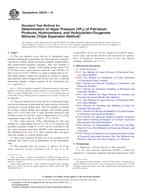Potřebujeme váš souhlas k využití jednotlivých dat, aby se vám mimo jiné mohly ukazovat informace týkající se vašich zájmů. Souhlas udělíte kliknutím na tlačítko „OK“.
ASTM D6378-10
Standard Test Method for Determination of Vapor Pressure (VPX) of Petroleum Products, Hydrocarbons, and Hydrocarbon-Oxygenate Mixtures (Triple Expansion Method)
Automaticky přeložený název:
Standardní zkušební metoda pro stanovení tlak par (VPX) ropných produktů, uhlovodíky a uhlovodíky-okysličovadlo směsí (Triple Expansion Method)
NORMA vydána dne 1.10.2010
Informace o normě:
Označení normy: ASTM D6378-10
Poznámka: NEPLATNÁ
Datum vydání normy: 1.10.2010
Kód zboží: NS-34891
Počet stran: 14
Přibližná hmotnost: 42 g (0.09 liber)
Země: Americká technická norma
Kategorie: Technické normy ASTM
Kategorie - podobné normy:
Anotace textu normy ASTM D6378-10 :
Keywords:
aviation turbine fuel, dry vapor pressure, gasoline, gasoline and gasoline-oxygenate blends, hydrocarbon-oxygenate blends, mini method, petroleum products, vapor pressure, variable volume method, Automated procedures--petroleum products analysis, Dry vapor pressure, Hydrocarbon-oxygenate blends, Mini method, Petroleum products, Triple expansion method, Vapor pressure (VPx)--petroleum products, Variable volume method, ICS Number Code 75.080 (Petroleum products in general)
Doplňující informace
| Significance and Use | ||||||||||||||||||||||
|
Vapor pressure is a very important physical property of volatile liquids for shipping and storage. The vapor pressure of gasoline and gasoline-oxygenate blends is regulated by various government agencies. Specifications for volatile petroleum products generally include vapor pressure limits to ensure products of suitable volatility performance. In this test method, an air saturation procedure prior to the measurement is not required, thus eliminating losses of high volatile compounds during this step. This test method is faster and minimizes potential errors from improper air saturation. This test method permits VPX determinations in the field. This test method can be applied in online applications in which an air saturation procedure prior to the measurement cannot be performed. |
||||||||||||||||||||||
| 1. Scope | ||||||||||||||||||||||
|
1.1 This test method covers the use of automated vapor pressure instruments to determine the vapor pressure exerted in vacuum by volatile, liquid petroleum products, hydrocarbons, and hydrocarbon-oxygenate mixtures. This test method is suitable for testing samples with boiling points above 0°C (32°F) that exert a vapor pressure between 7 and 150 kPa (1.0 and 21 psi) at 37.8°C (100°F) at a vapor-to-liquid ratio of 4:1. The liquid sample volume size required for analysis is dependent upon the vapor-to-liquid ratio chosen (see Note 1) and the measuring chamber volume capacity of the instrument (see 6.1.1 and Note 3). Note 1—The test method is suitable for the determination of the vapor pressure of volatile, liquid petroleum products at temperatures from 0 to 100°C at vapor to liquid ratios of 4:1 to 1:1 (X = 4 to 1) and pressures up to 500 kPa (70 psi), but the precision statement (see Section 16) may not be applicable. 1.2 This test method also covers the use of automated vapor pressure instruments to determine the vapor pressure exerted in vacuum by aviation turbine fuels. This test method is suitable for testing aviation turbine fuel samples with boiling points above 0°C (32°F) that exert a vapor pressure between 0 and 110 kPa (0 and 15.5 psi) at a vapor-to-liquid ratio of 4:1, in the temperature range from 25 to 100°C (77 to 212°F). 1.3 The vapor pressure (VPX) determined by this test method at a vapor-liquid ratio of 4:1 (X = 4) of gasoline and gasoline-oxygenate blends at 37.8°C can be correlated to the dry vapor pressure equivalent (DVPE) value determined by Test Method D5191 (see 16.3). This condition does not apply when the sample is aviation turbine fuel. 1.4 The values stated in SI units are to be regarded as the standard. The values given in parentheses are for information only. 1.5 This standard does not purport to address all of the safety concerns, if any, associated with its use. It is the responsibility of the user of this standard to establish appropriate safety and health practices and determine the applicability of regulatory limitations prior to use. For specific warning statements, see 7.2-7.8. |
||||||||||||||||||||||
| 2. Referenced Documents | ||||||||||||||||||||||
|
Doporučujeme:
Aktualizace technických norem
Chcete mít jistotu, že používáte pouze platné technické normy?
Nabízíme Vám řešení, které Vám zajistí měsíční přehled o aktuálnosti norem, které používáte.
Chcete vědět více informací? Podívejte se na tuto stránku.




 Cookies
Cookies
